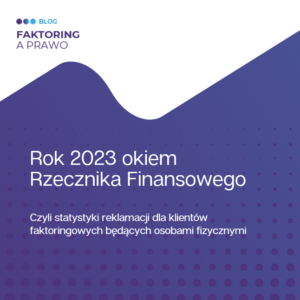Crif Ltd. has published the results of its 2020 Factoring Fraud Survey, based on surveys conducted for the Risk & Supervision Meeting conference. An article on the results is available on the Crif Ltd. website. HERE. The Risk & Supervision Meeting conference is organized annually by CRIF Ltd. - this year it will be held exceptionally on 10.09.2020. (about which more HERE). This year's survey was conducted in late March and early April, with the goal of identifying common risks, threats and trends in the sphere of fraud in the leasing and factoring sectors, with the ultimate result of defining and creating modern anti-fraud solutions for both industries. Of course, we were tempted to analyze the results of the survey and our own conclusions related to factoring fraud trends.
- Methods to combat abuse. Respondents pointed to external business information registries and industry-specific solutions based on Article 106d of the Banking Law (i.e., information exchange systems, databases on extortion, fraud, convictions, etc.) as the best method to combat fraud.
Comment: The group of anti-fraud methods is extremely broad. In addition to the above, the following can be pointed out: internal procedures (compliance), anti-fraud training, "fraud-proof" documentation, learning from mistakes and analyzing internal and external cases - including industry meetings, events and risk department meetings at PZF, whistleblowing, implemented KYC (Know Your Customer) principle, auditing and monitoring of debtors' assets, customer scoring, programs and other methods.
- Fraud detection techniques. Among the techniques used by factoring companies to detect fraud, the most popular include anomaly detection (100%), network analysis (80%) and analysis of publicly available data sources (80%).
Comment: On the plus side, access to better and better solutions for verification of factoring and other factoring participants should be evaluated. In particular, free databases such as KRS on-line, on-line financial statements (MF portal), and the upcoming National Register of Debtors. This undoubtedly facilitates the daily work of risk departments, but also operational departments. In addition, technology gives us tremendous opportunities to determine the personal and capital ties of participants in factoring frauds, who nowadays leave traces on the Internet. The power of the Internet is increasing the chances of effective debt collection, including unraveling fraud, or targeting hit debt seizures. However, with such a plethora of databases, due to their multiplicity and dispersion, the greater the role of entities such as CRIF, which are able to make a complementary combination of databases into one coherent and transparent whole, and provide pragmatic solutions to collect, synthesize and use the information in terms of the expectations of financial institutions.
- Level of expenditure. Interestingly, as many as 60% factoring companies surveyed describe the level of anti-fraud spending as too low.
Comment: This, of course, captures the reality of the business of budgeting versus reality. At this point, I encourage you to include in your annual budgeting expenses both for modern IT solutions and for trainings on the subject of counteracting factoring frauds.
- Obstacles. The lack of information on all unreliable customers (100%), the lack of cooperation between the insurance and factoring industries due to legal restrictions (80%), as well as the lack of easy access to databases maintained by government authorities, i.e. CEPiK (60%) and the inability to verify the authenticity of documents, e.g. PIT/CIT declarations (60%), were identified as obstacles to countering fraud.
Comment: Offensive legislation at both the EU and PL levels (including, among others, RODO) has screwed up a certain spiral of fear regarding the processing of personal data of participants in factoring transactions (including not only factors, but also recipients, guarantors, etc.) in order to prevent factoring fraud, and such action is, after all, a legitimate interest of the factoring company as a data controller, and very often also aimed at exercising any creditor rights. This certainly limits trans-industry cooperation, yet the finance and insurance sector could better protect each other from fraudsters. This makes it all the more challenging to legally exchange information. In terms of tax returns, it is also worth mentioning that a big future undoubtedly lies ahead of modern software precisely for validating and confirming the authenticity of tax returns, and especially for catching anomalies and inconsistencies in JPK files.
- Gaps in access to information sources. The lack of a single dedicated business intelligence service linking all sources together with Internet search results (100%) as well as the lack of access to information on tax arrears (80%) or the relationship of a sole proprietorship to those appearing in the KRS (80%) were cited as deficiencies in access to information sources.
Comment: Here, undoubtedly, a major challenge for the IT-software industry to meet the expectations of the factoring industry.
- Effectiveness of methods. A stand-alone internal team dedicated to detecting irregularities and fighting fraud was identified as the most effective method.
Comment: I fully share the above assessment of the surveyed entities. The core for factoring entities to build and develop their own anti-fraud system as part of broader compliance is a qualified internal team. Sometimes it takes the form of a separate risk department, but acting complementarily it should in fact include risk, legal, operations, relationship maintenance and sales staff working together. Such a team should, of course, be qualified, experienced and trained, but should also be equipped with uninterrupted access to modern tools allowing, among other things, to examine the counterparty's ability to pay, determine the real beneficiary, research links between the factor and the recipient, catch suspicious transactions and anomalies in transactions (e.g., when factoring in invoices submitted for financing). These types of solutions allow to relieve the financial institution's risk department from monitoring hundreds or even thousands of transactions, often on a small volume (e.g. micro factoring) where excessive involvement of the human factor will be unprofitable.
Other conclusions we derive from the analysis of survey results:
- Modus operandi financial fraudsters are evolving, but some classic fraud risks that are the bane of the financial sector are invariably present.
- One can observe an increasingly lower threshold of entry into the world of financial crime. This is due, in our opinion, to the simplicity of setting up a business in Poland, including, for example, forming a company or acquiring its shares, as well as creating the appearance of a credible company based on an attractive address and a good Internet impression, which can be achieved at a relatively low cost. This is compounded by the financial segment's desire to simplify documentation and procedures as much as possible in order to make them more accessible and thus marketing advantageous.
- The survey was for 2019, so the results in fact do not take into account what is happening in the economy during the crisis caused by the coronavirus pandemic. As is well known, "the propensity to cheat increases during a crisis." We have written extensively about the possible effects of the coronavirus pandemic on the factoring industry here. It is only worth adding that already in the period of May-June 2020, some signals can be observed indicating the possibility of intensification of fraudulent activities, such as an increase in congestion, increased number of restructuring requests, maximum use of factoring limits, increased number of corrective invoices, delayed pace of work of courts and enforcement agencies related to the suspension of judicial and administrative deadlines, high volatility in the valuation of assets and raw materials.
- It is also worth remembering when evaluating the survey that factoring in Poland involves both the entities generating the highest turnover (factoring departments of banks), as well as companies controlled by banks, and finally non-banking entities, or companies with a banking and factoring profile, as well as fintechs operating mainly in micro factoring. Fraud risks in these types of entities differ significantly, in the case of banks the most significant will be risks related to the solvency of recipients who may account for a large part of the factoring portfolio, and in the case of micro factoring the risk of cybercrime is greater. Companies have a completely different tolerance for and profile of factoring risk, which also has to do with the approach to the subject of fraud.
- Finally, it is worth remembering that the survey represents a certain "market sample" and concerns a few entities operating in the market with an established position and significant turnover. Meanwhile, according to various sources, factoring services in Poland are provided on a commercial scale by at least 25-40 entities, and if we also take into account entities providing such services for their own groups, or traces, the total number of entities should close in 60-100.







